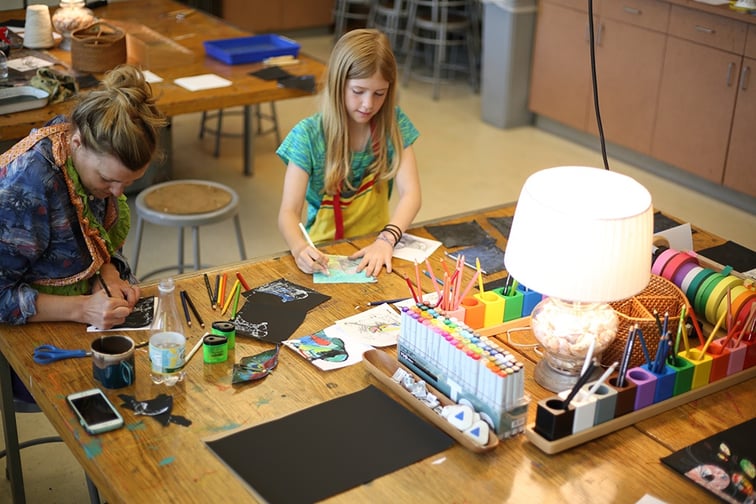The value of art class goes far beyond helping children develop their skills with painting or sculpture. As kids learn to be artists, they are developing life skills that will help prepare them for their future — whether they become professional artists or not.
Here are 6 Life Skills that Kids Learn During Art Class:
1. How to Observe and Look Closer
When we start teaching kids art, they’re direct and have a simplistic technique and approach. For example, if I ask a young child, “Would you please draw a person for me?” they’ll start by drawing a circle for the head and then lines for the body and hands.
New artists start with stick figures, then move on to basic shapes. As an artist evolves, their work can sometimes dive deeper and really look at what defines the subject of their art. That’s why I ask kids to take a closer look at what they’re creating. Perhaps that person has a strong jawline and their face is better represented by a rectangle. Or their arms may be longer than someone expects them to be. Art may challenge kids to take a deeper look at a person and see them for who they really are.
2. How to Feel Empathy
When kids start a work of art it's fun and engaging but sometimes they have the opportunity to consider just how to bring that person to life. By asking students questions and encouraging more of a discussion they can begin to see all the possibilities they have in creating.
An art teacher can take the role of someone who challenges students to go beyond a simple drawing to understanding what it really means to be that person. Though some art is all about the artist's perspective, another approach looks at a person without imposing preconceived notions on them, but adapting the work to fit the personality of the model. For example, if someone has a very dynamic personality, it’s important to choose the proper materials and application techniques for the portrait. Kids learn that to create a portrait of a person, they have to put themselves in that person’s shoes and learn to understand their perspective. This helps students develop empathy and open-mindedness.
3. Tell Stories
Just like in a story, art is more powerful when viewers feel they connect with the people and concepts within it. Young children are natural storytellers and art gives them a method of telling a story without using words. As students become older they can discover and grow art as a way to share their own story and develop their own lexicon that maybe only they understand completely, it can be liberating and exciting for a middle school student to feel like they have their own secret non-verbal language.
4. Solve Problems
I use many different approaches in teaching art because every student has a different way of creating but as children dive into creating art, they also discover which creative process works best for them. A student may start off by creating “thumbnail sketches” before they dive into a project. That helps them develop variations on a theme, as well as to plan the placement of their compositions, and explore different color schemes and combinations as well as potential material and media choices.
As students develop their artistic skills, they learn how to see something as a challenge they can tackle instead of a problem. Art can be about process and for students, it’s about learning to understand their own process in that creation. They need to think about the materials they need, and what order they need to create their piece.
In one approach to teaching, I tell students, "If you are building a house, you have to first create the framework before you paint the walls." This relates to drawing because you must also plan, consider and build the foundation of a drawing. A drawing is “built,” not magically created. For example, in an observational drawing, you must first sketch the basic shapes to create the composition, then you go to “value,” which is using different lightnesses or darknesses of a color to build the form of the object. The last step is to add details.
Kids also learn how to choose the techniques that get the result that they want. They learn from trial and error when to use a fan brush and when to use a flat brush. They discover that line density and pressure on the paper matter and that different colors evoke specific emotions. As they become more experienced with creating art, they get a lot of practice choosing the specific techniques and mediums that are the best fit for what they want to create.
By helping kids see connections between artists, we’re helping them to see art has evolved—I believe this can give courage to the young artists in appreciating their individuality and unique perspective.
5. See Connections
The art world is filled with artists having vastly different points of view. As we’re helping kids learn about art, we challenge them to think about how the artists are connected to each other and how they are part of the time and place in which they lived. We talk about movements in art, how they’ve evolved in the past due to culture, place and style, and how art is still evolving today. For example, we talk about all the factors that helped inspire Picasso to create cubism and his impact on the art world.
By helping kids see connections between artists, we’re helping them to see art has evolved—I believe this can give courage to the young artists in appreciating their individuality and unique perspective. Just because something is different doesn’t mean it’s better or worse—what’s really important is how it’s deepening a student's understanding.
6. Trust in their Own Abilities
Researchers often find that there’s a gap between how many young children think they’re artists, and how many teens and adults do. What happens is that as kids grow up, they start to believe that they can only be artists if they can draw (or that drawing ability somehow indicates creativity.)
At Whitby, we believe that every child has the potential to be an artist—all they need to do is find what works for them. Each student has different abilities because each student is different. One might have an eye for proportion, while another will be skilled at color. Our program is focused on giving students many different experiences with art so they find a medium and process they connect with. We also focus on helping students understand that there are skill involved. If they find a medium that they enjoy and practice it, they’ll improve.
Through practice, students improve and gain confidence and it helps them believe in their own abilities. It’s not that they can’t do something, it’s just that they haven’t found the approach that works best for them yet. This helps them develop confidence in their ability to take on challenges in many other areas of their life.
Art Class Helps Children Grow
When children get a chance to express their creativity and dive into art, they develop confidence, increase their empathy and discover how to look at the world from different perspectives. All those skills help prepare students to take on the world with passion and creativity.



